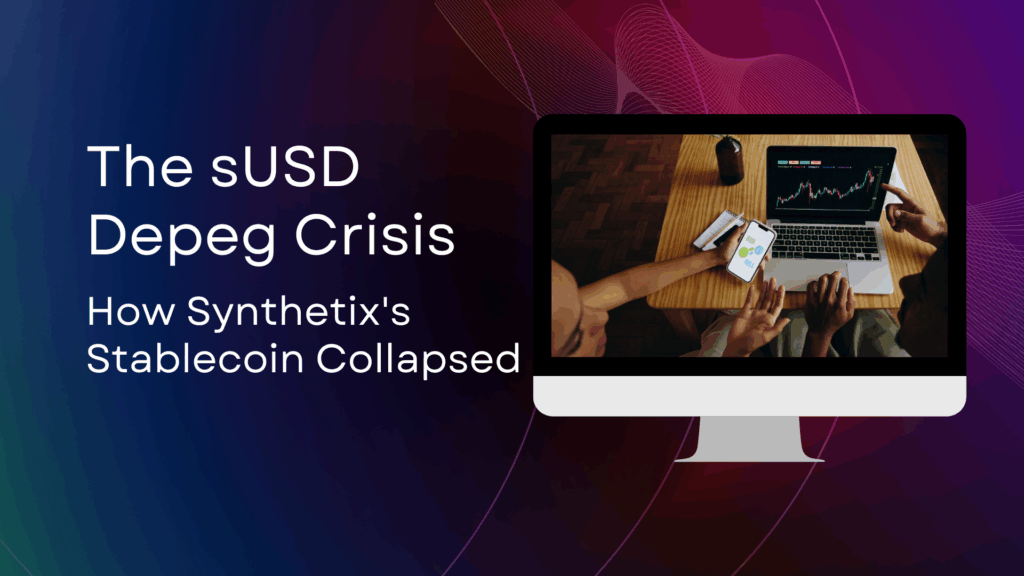The sUSD Depeg Crisis: How Synthetix’s Stablecoin Collapsed
The cryptocurrency market is no stranger to volatility, but the sUSD depegging crisis in 2022 marked a pivotal moment for stablecoin stability and decentralized finance (DeFi). Developed by Synthetix, sUSD was a collateralized stablecoin designed to maintain a 1:1 peg to the U.S. dollar. However, in May 2022, it plummeted to $0.70, exposing critical flaws in its design and triggering a reckoning for the DeFi ecosystem. This article explores what happened to sUSD, the factors behind its collapse, and the broader implications for the future of stablecoins.
What is sUSD and How Did It Work?
Background of Synthetix and sUSD
Synthetix is a DeFi protocol that allows users to create synthetic assets (like sUSD) by collateralizing ETH on the Ethereum blockchain. sUSD was a non-custodial stablecoin, meaning users controlled their own funds, and its value was theoretically backed 150–300% by ETH.
The Peg Mechanism
sUSD aimed to stay within a $0.95–$1.05 range through collateralization ratios. If the price dipped below this range, users could burn sUSD to reclaim their ETH collateral, theoretically stabilizing the peg.
The Depegging Crisis: Timeline and Key Events
May 2022: The Crypto Market Crash
The sUSD crisis unfolded during the broader crypto market crash of May 2022, triggered by Luna/Terra’s collapse and Solana’s liquidity crisis.
- May 9–10: sUSD dropped to $0.86, as ETH prices fell and panic selling intensified.
- May 11: sUSD hit $0.70, with Synthetix’s total value locked (TVL) dropping by 80%.
Why Did the Peg Fail?
- Overcollateralization Mismanagement:
- Users could overcollateralize sUSD with ETH, but during a market crash, ETH’s value dropped faster than sUSD’s demand, creating a death spiral.
- Smart Contract Flaws:
- The system lacked external liquidity safeguards, relying solely on user participation to burn sUSD.
- Loss of Confidence:
- Panic-driven sUSD sales outpaced collateral redemption, accelerating the depeg.
Root Causes: Overcollateralization and Market Volatility
1. Collateralization Ratio Design Flaw
Synthetix required users to collateralize 300% ETH for sUSD issuance. However, during a crash:
- ETH prices fell, reducing collateral value.
- Users rushed to sell sUSD, but the protocol couldn’t redeem collateral fast enough.
2. Liquidity Drain
The protocol relied on user-driven liquidity, which evaporated as holders exited DeFi en masse. Unlike centralized stablecoins (e.g., USDT/USDC), sUSD had no reserve buffer to absorb shocks.
3. Smart Contract Limitations
The system lacked automatic stabilizers, such as:
- Algorithmic adjustments to mint/burn sUSD.
- Liquidity pools to absorb volatility.
Impact on Users and the Market
1. Investor Losses
- Users holding sUSD lost up to 30% of their value at the trough.
- Synthetix’s TVL dropped from $2.5 billion to $400 million in days.
2. Trust Erosion
- sUSD’s depeg fueled skepticism about algorithmic stablecoins, with critics arguing that over-reliance on collateral ratios is risky.
- The incident highlighted the interconnectedness of DeFi protocols; Luna’s collapse in April 2022 spread panic to sUSD.
3. Regulatory Scrutiny
- U.S. regulators intensified scrutiny of stablecoins, leading to proposals like the Stablecoin TRUST Act.
Synthetix’s Response and Recovery Efforts
Immediate Actions
- Emergency Collateral Ratio Adjustment: Synthetix increased the required collateral to 800% to incentivize sUSD burning.
- Airdrops of sUSD: The protocol distributed free sUSD to users to encourage redemption.
Long-Term Reforms
- Oracle Integration: Added Chainlink oracles to improve price feed reliability.
- Liquidity Pools: Partnered with decentralized exchanges (e.g., Uniswap) to create sUSD liquidity buffers.
- Governance Upgrades: Enhanced community voting processes to address crises faster.
Lessons for the Crypto Industry
1. Collateral Management Matters
- Overcollateralization alone isn’t enough; protocols must balance price stability with liquidity safeguards.
2. Diversification and Buffer Reserves
- Stablecoins should hold mixed reserves (e.g., ETH + Tether) or algorithmic mechanisms to absorb volatility.
3. Transparent Governance
- Clear emergency protocols and voter-activated liquidity measures can prevent panic-driven collapses.
4. Regulatory Collaboration
- The incident underscored the need for oversight frameworks to ensure stablecoins don’t destabilize broader markets.
Current Status and Future Outlook
As of early 2024, sUSD has regained its peg but operates at a fraction of its former volume. Synthetix’s TVL remains $450 million, down from pre-crisis highs.
Key Takeaways for Traders and Investors
- Avoid Overcollateralized Coins in Bull Markets: They’re riskier during downturns.
- Diversify Stablecoin Holdings: Use USDC, USDT, and DAI alongside algorithmic options.
FAQ: The sUSD Depeg Crisis
Q1: Why did sUSD lose its peg?
- A: Market panic, ETH price drops, and lack of liquidity safeguards caused a death spiral.
Q2: Is sUSD safe to use now?
- A: It’s stable but less popular. Users should monitor collateral ratios and protocol health.
Q3: How did Synthetix recover?
- A: Increased collateral requirements, liquidity partnerships, and governance upgrades.
Q4: What’s the difference between sUSD and USDT?
- A: USDT is centralized and backed by USD reserves; sUSD is decentralized and overcollateralized by ETH.
Q5: Could this happen to other stablecoins?
- A: Yes, especially algorithmic ones. Centralized stablecoins are safer but less decentralized.
Conclusion: The sUSD Crisis as a Wake-Up Call
The sUSD depegging was a stark reminder of DeFi’s risks and the importance of resilience. While the incident hurt Synthetix, it also pushed the industry toward better safeguards. As stablecoins become a $200+ billion market, protocols must prioritize transparency, liquidity, and emergency preparedness to avoid repeating history.

